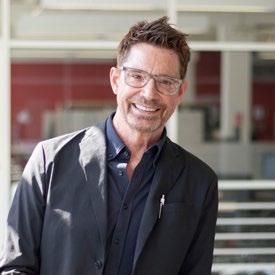
6 minute read
An Architect and Former Educator’s Perspective on the Importance of School Design
4AN ARCHITECT AND FORMER EDUCATOR’S PERSPECTIVE ON THE IMPORTANCE OF SCHOOL DESIGN
by By: Mark McCarthy AIA, LEED AP, Design Director at CSArch
In memory of Christine Schlendorf, AIA. My former partner, friend, and a dedicated champion of school design for all.
Sn the late 1980s after studying Fine Arts at SUNY New Paltz, I had enough education credits for a temporary license to teach in the New York City public school system. At the time, the city was dealing with a drug epidemic, heightened crime rate, and an increasing challenge to find qualified teachers. Days after agreeing to substitute teach at a middle school in Crown Heights, Brooklyn, I accepted a full-time position as a science and homeroom teacher. Despite having not taken a science course for years, I was happy to be part of the core faculty and a homeroom teacher responsible for my students beyond the curriculum requirements. I wanted to be challenged and was ready to make a difference in the young lives of those most impacted by an education system in flux. Although my world was almost entirely within the four walls of my classroom, I do not remember being particularly interested in the physical spaces of the building. Located on the ground floor near the back entry, my classroom had a large window with a metal grill covering for safety. The cabinets were old and filled with outdated materials I rarely used. My students sat in rows of desks, and I was happy if they settled down long enough for me to start the lesson. With no formal education degree or experience teaching in a classroom setting, I was underprepared and overwhelmed. I receive little guidance or lesson plans; rather, I was told that it was enough to work on reading comprehension to prepare students for state testing in the spring. It was the hardest job I have ever had and at three o’clock I was spent. Despite those challenges, the community, faculty, and students welcomed and supported me, and the day I left triggered more real emotions than I have ever felt in any other time in my professional career. I saw many teachers who were truly gifted, which helped me realize that this was not the right career path for me. After two years of teaching, I moved on to pursue a master’s in archi-
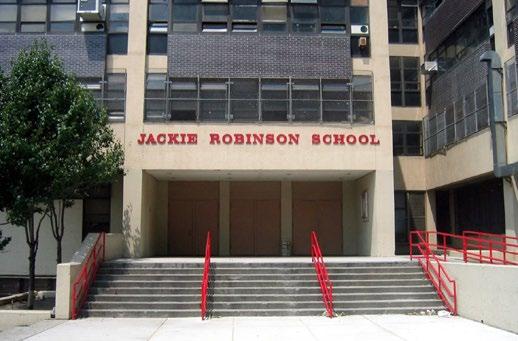
Former IS 320, now Jackie Robinson Elementary School, in Crown Heights, Brooklyn. Mark’s classroom was just to the right.
tecture at the University of Pennsylvania. During my time as a teacher, I was so consumed in the well-being and success of my students that my only concerns regarding the building were finding the copier and a safe place to park. However, it was those experiences that shaped my perspective and approach as an architect and helped me understand how people in different roles view educational space. The majority of my 25-year career as an architect has focused on the design of learning spaces for primary and secondary education, with work extending from public and charter schools in New York to international schools in China and the Middle East. While the type of work has varied to include renovations, new construction, and five-year plans for urban, suburban, and rural districts, my time in the classroom has kept my approach simple and grounded. As architects, it is easy to get carried away in the minute details of a given space, but sometimes teachers simply require a space that is unobtrusive and functional, allowing them to juggle numerous responsibilities without really thinking about the building at all. When I look at both my time as a teacher and career as an architect, I often return to four critical elements of school design:
INSPIRE: Like a church or a museum, school design should transform the lives of those who use it. Schools are special spaces that educate, empower, and engage learners, teachers, and the community. Inspiring space does not necessarily have to be grand, but through scale, material, and light, spaces change our relationship to the world. COMFORT: Comfort is not just about temperature, but also includes scale and design that is fit for all ages, abilities, and backgrounds. Comfort includes ideas of sustainability, as well as air quality, acoustics, and light to provide space that does not distract or hinder students’ ability to learn.
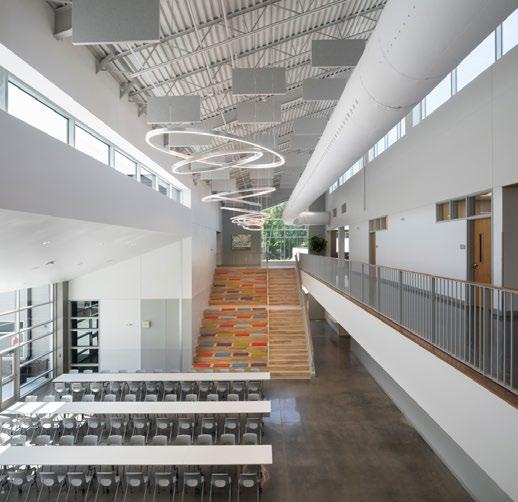
Corvian High school, Charlotte NC. Multi-purpose space serves as the dining space as well as a place for performance or assembly. Natural light comes from 3 directions. (Photo Credit: © ksq design) Dream Academy, East Harlem, NY. A small niche in the corridor serves as a breakout teaching space for small groups and a connection to a roof terrace with gardens. (Photo Credits: © Perkins Eastman)
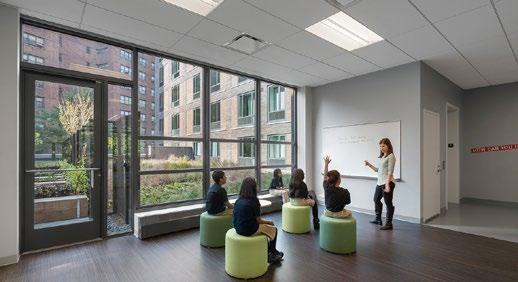
ADAPT: Don’t just design for tomorrow. Schools and educational trends change often and, as architects, we need to embrace and plan for that while understanding that buildings last 40 to 50 years or more. While flexibility pertains more to the day-to-day, multi-purpose nature of space, adaptability focuses on how a simple, sturdy building design can provide useful and easy-to-maintain spaces capable of supporting different programmatic uses over time.
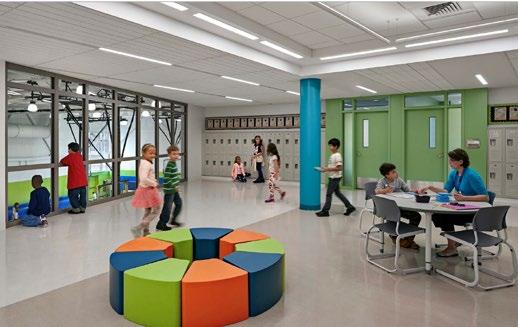
Charter Oak International Magnet School, West Hartford, Small classroom space left open to the corridor for impromptu learning and flexibility. This space is “unprogrammed” to allow for change. Visually connected to the gymnasium below. (Photo Credit: © Perkins Eastman)
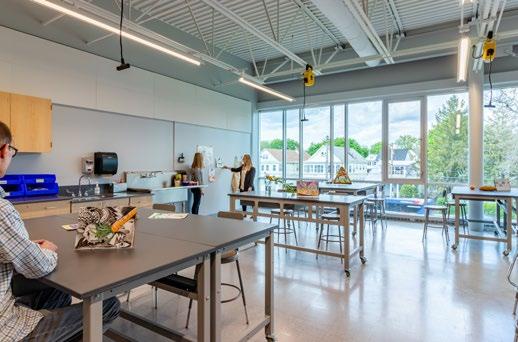
The complete renovation and expansion of Albany High School added much-needed natural light to every learning space, providing a positive environment for students and teachers. (Photo Credits: © CSArch)
PURPOSE: Every design decision should convey intention. Purposeful education design should be simple, safe, and durable, not fussy or imposing the architect’s vision. Organization and hierarchy should be clear with wayfinding that is natural and intuitive. Most importantly, design for education should maximize natural light that enhances energy savings and provides a positive physiological effect on students and faculty. Even in the most urban places, making connections to the outside using biophilic design principles serves a critical purpose in promoting health and well-being. The complete renovation and expansion of Albany High School added much-needed natural light to every learning space, providing a positive environment for students and teachers. As an architect and former teacher, my experiences have given me a unique approach that views design from an educator’s perspective. At a time when the need and desire for in-person learning is more apparent than ever, architects can take a step back to best understand the qualities of school design that enable people to do such important work. This past year has reminded us that we cannot predict how the spaces we create will need to serve. The eventual return to normalcy will surely reveal a heightened emphasis on healthy learning spaces that promote collaborative, hands-on learning, and school design should continue to support these trends." l With more than 25 years of experience leading design teams through various project types, Mark brings a level of insight and collaboration that ensures a successful outcome. Mark’s career has focused on the design of educational facilities for public and private institutions. As an architect from a family of educators, he engages others with his thoughtfulness, creativity, and hands-on approach to project management.
Modular International, Inc.
Innovative Architectural Lighting

3941 California Avenue Pittsburgh, PA 15212 1-412-734-9000
www.ModularInternational.com








